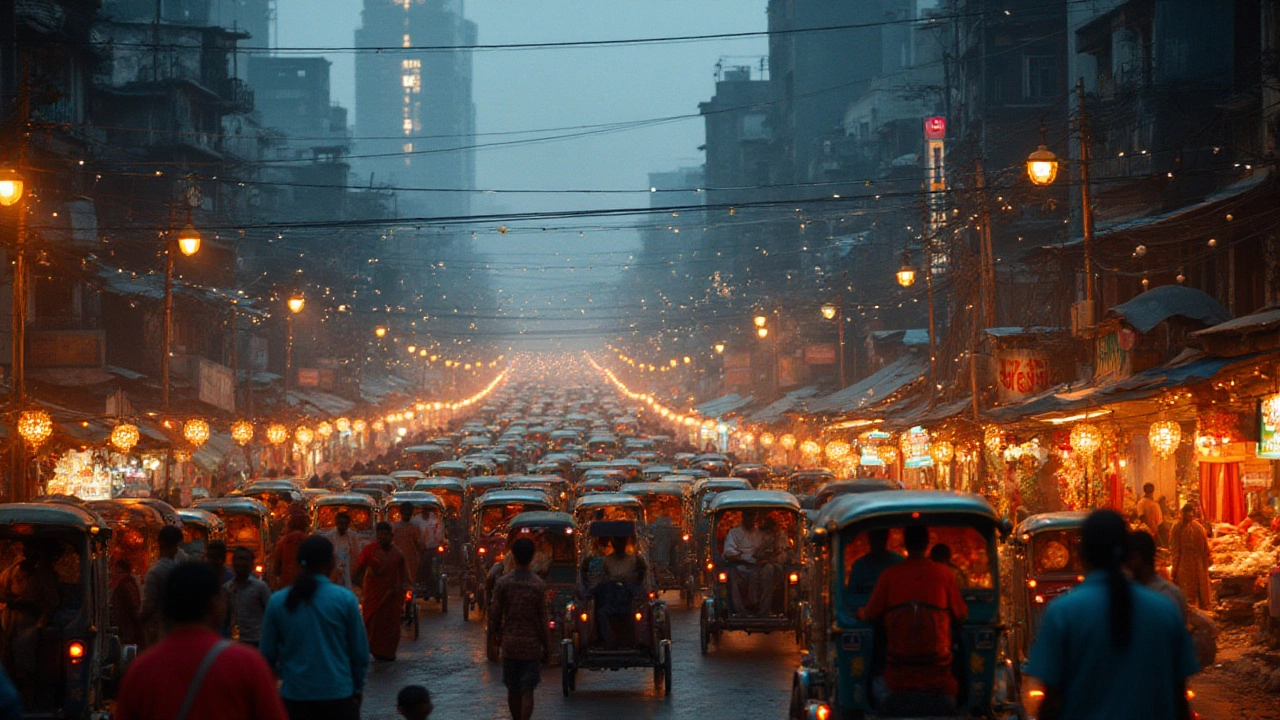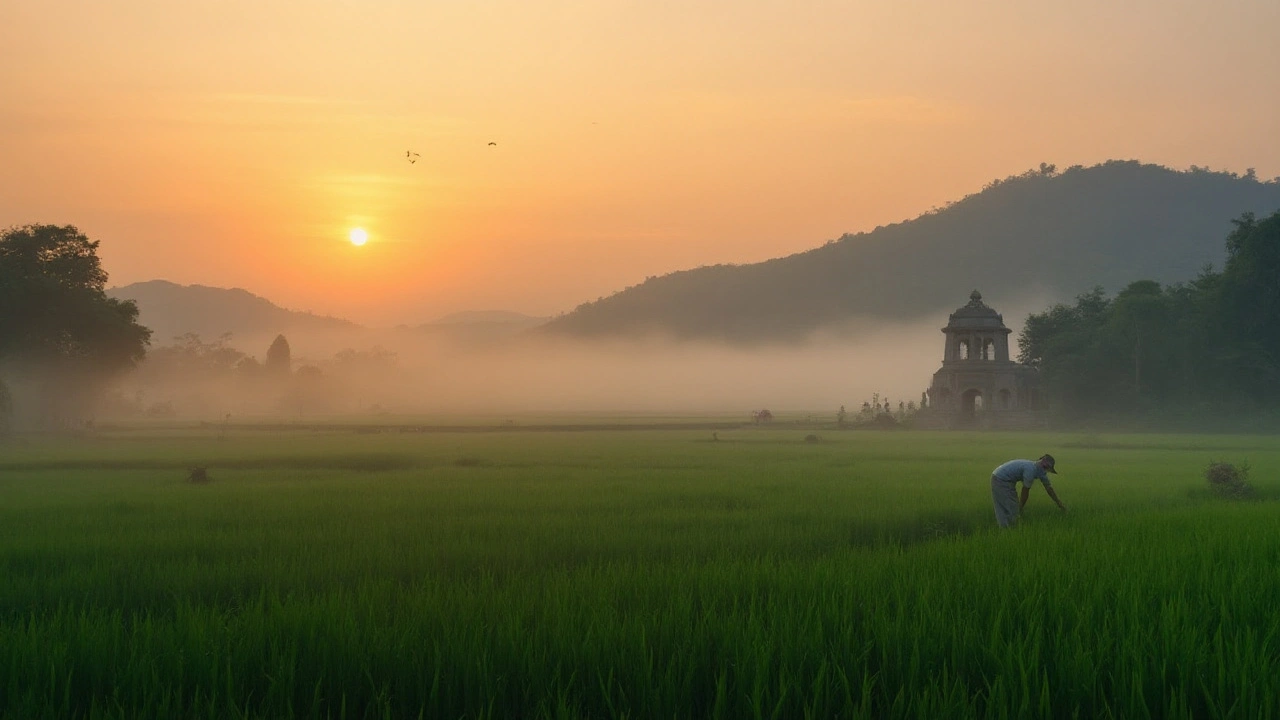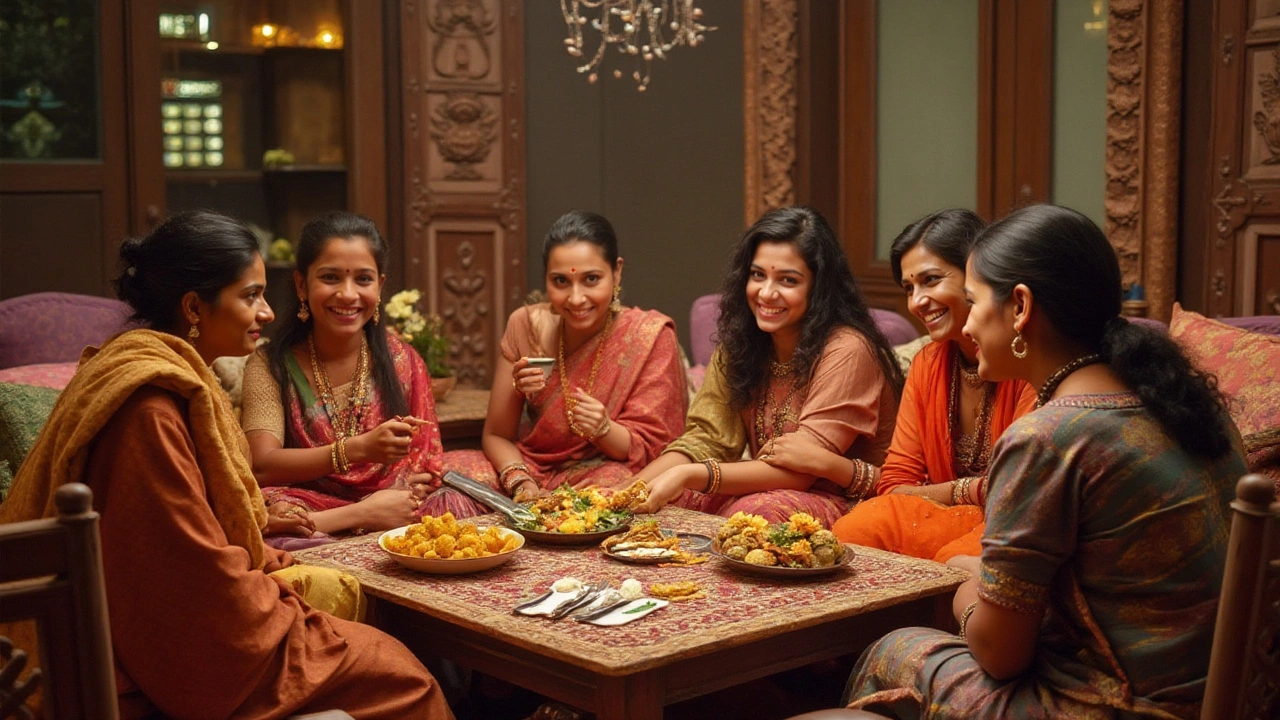
Living in India is nothing short of an adventure filled with vibrant colors, diverse traditions, and a myriad of experiences. With its rich heritage and rapidly evolving modernity, residing here offers a unique perspective on life. The bustling cities teem with energy, while the countryside offers a peaceful respite.
India's cultural diversity is one of its greatest charms. Each region boasts its own language, cuisine, and customs, making every corner a new discovery. Whether participating in festivals or savoring local delicacies, the cultural tapestry of India is both inviting and intriguing.
Adapting to life in India requires openness to the unexpected and an appreciation for its unique way of life. From understanding local customs to navigating its multilayered societal structure, living in India is an enriching journey. Despite the challenges, the warmth of its people and the richness of experiences make it a truly rewarding place to call home.
- Cultural Diversity and Traditions
- Urban vs. Rural Living
- Cost of Living and Economy
- Daily Life and Social Interactions
- Adjustments and Learning Experiences
Cultural Diversity and Traditions
India's vast expanse harbors an extraordinary cultural diversity and tradition that few countries can match. With over 1.4 billion people, India is home to a mosaic of religions, languages, and traditions that coalesce into an awe-inspiring cultural tapestry. The country's heritage thrives on its ability to embrace both old and new, making its culture a living, breathing entity. Driven by a deep-seated reverence for customs, Indian society often finds itself celebrating life through festivals, rituals, and art.
Indian festivals are a prime example of how deeply the culture celebrates life. Events like Diwali, the Festival of Lights, showcase the triumph of good over evil and are celebrated with fervor across the nation. Then there's Holi, the festival of colors, where streets erupt into a riot of hues symbolizing joy and the arrival of spring. These festivals aren't confined to specific regions but bring together people from different backgrounds, fostering a spirit of unity. As noted by the famous Indian author, R.K. Narayan,
"We are all a little weird and life's a little weird, and when we find someone whose weirdness is compatible with ours, we join up with them and fall in mutual weirdness and call it love."
Language is another incredible aspect of Indian culture. The country recognizes 22 official languages, not to mention the myriad dialects spoken across its regions. Hindi and English remain the predominant tongues, but languages like Bengali, Tamil, and Telugu comprise significant portions of linguistic demographics. In each of these languages, rich literary traditions have evolved over centuries, offering profound insights into the human condition. Engaging in conversations with locals can often lead to delightful discoveries of proverbs and stories passed down through generations, highlighting the contagious warmth of the people.
Religion plays a pivotal role in shaping India's cultural landscape. It is the birthplace of major religions like Hinduism, Buddhism, Jainism, and Sikhism, while Islam and Christianity also have a significant presence. The confluence of these belief systems has crafted a unique spiritual ethos that permeates daily life in India. Sacred sites, from the ghats in Varanasi to the Golden Temple in Amritsar, beckon spiritual seekers and tourists alike. Walking through these sites offers more than a glimpse into India's spiritual soul, it provides a journey into the heart of its traditions that continue to thrive amidst the hustle of the present day.
Art forms in India reflect the country's cultural ethos in stupefying variety. Classical dance forms such as Bharatanatyam and Kathak capture the grace and storytelling prowess of Indian art. The ubiquitous Bollywood industry serves as a global ambassador for Indian culture, weaving contemporary narratives with vibrant dance and music that often borrow from traditional roots. Crafts, too, shine as exemplars of age-old skills, where artisans create everything from intricate textiles to awe-inspiring jewelry. This artisanship not only supports large communities but also ensures that these skills are passed on to future generations, ensuring their survival in the modern era.
There exists a delicate balance between old and new in living in India. Witnessing the youth finding ways to blend tradition with modern aspirations is a testament to India's resilience. They wear traditional attire for a wedding, yet it is not surprising to find them operating the latest tech beneath their colorful fabrics. It speaks of a culture that is neither stagnant nor entirely swept up in the tide of modernity, and this equilibrium between tradition and innovation crafts a truly mesmerising living experience.
Urban vs. Rural Living
The pulse of life varies dramatically when comparing urban and rural settings in India. In the sprawling metropolises like Mumbai, Delhi, or Bangalore, the pace is electric and relentless. These cities are a melting pot of cultures and lifestyles, driven by a fast-paced, economically vibrant environment. In such places, convenience is king—24/7 services, rapid public transport, and a seemingly endless array of dining, shopping, and entertainment options cater to every conceivable need. The urban lifestyle attracts ambitious professionals from all corners of the nation, keen to capitalize on the career opportunities presented by burgeoning industries and multinational companies establishing their footholds.
In stark contrast, rural India paints a different picture, where life unfolds at a significantly slower pace. The heart of rural areas beats in harmony with agricultural cycles and timeless traditions passed down through generations. The serenity and simplicity often found in villages present an appeal far removed from the urban rush. There's a palpable sense of community and closeness in rural living that many find reassuring and comforting. However, rural areas may lack the infrastructure and amenities that urban life boasts, such as reliable electricity, advanced healthcare, and high-quality educational institutes. Yet, the charm of wide-open spaces, clean air, and self-sufficient practices hold their own allure.
When discussing the contrasts, it's vital to highlight the economic disparities. Urban areas contribute significantly to India's GDP growth, driving economic expansion with their focus on commerce and industry. In contrast, rural regions primarily depend on agriculture and are more vulnerable to natural calamities and fluctuating market demands. A noteworthy initiative bridging these two worlds is the government's focus on improving connectivity through digital pathways, aiming to empower rural inhabitants by providing better access to information, education, and marketplaces online.
"According to the World Bank, nearly 66% of India's population still resides in rural areas, yet urban centers generate over 70% of the nation's GDP," highlighting the crucial economic imbalance and its potential implications on the country's development trajectory.
The choice between urban and rural living in India ultimately hinges on personal preference and priorities. Some are drawn to the fast-paced, opportunity-rich urban environments, while others find solace in the rustic charm of rural life. Each carries its unique blend of challenges and rewards. With an increasing focus on sustainable development and the rise of remote working cultures, it's becoming ever more plausible for individuals to enjoy the best of both worlds, integrating technological advantages to enjoy a balanced lifestyle.

Cost of Living and Economy
Living in India presents a varied landscape when it comes to cost of living and economic dynamics. The country presents a fascinating juxtaposition, with cost elements spanning a wide spectrum. For someone living in a bustling metropolis like Mumbai or Bengaluru, the expenses for food, housing, and transportation significantly differ from those residing in smaller towns like Jaipur or Kochi. Real estate and rental prices in large cities can be exceptionally high, reflecting the global trend of urbanization and overcrowding. However, the cost of local goods, services, and public transportation tends to be relatively lower, contributing to a balancing act for many households.
India's economy, one of the fastest-growing in the world, is deeply complex. The service sector, which includes IT, banking, and hospitality, significantly bolsters economic growth, providing employment opportunities and enhancing living standards for a considerable segment of the population. Agricultural practices, although witnessing challenges, still form the economic backbone of rural India, supporting millions of livelihoods. The government continually enacts reforms aimed at boosting economic performance and rural development, though their impact varies considerably.
"India's growth story is a compelling one, given the diverse mix of sectors contributing to its GDP," said renowned economist Raghuram Rajan, emphasizing the multifaceted nature of the Indian economy.
An interesting aspect lies in India's burgeoning startup ecosystem, which injects innovation and entrepreneurship into the economy. This vibrant scene is supported by a young, dynamic workforce that is increasingly steering away from traditional job roles to create new businesses, further diversifying the economic landscape. While navigating economic challenges like inflation or income disparities can be complex, the Indian consumer market continues to expand, driven by rising disposable incomes and changing lifestyles.
The disparity in cost of living correlates closely with income levels, where stark contrasts exist. While metropolitan areas showcase affluence with luxury brands and high-end shopping locales, other regions focus on local markets. Many individuals find opportunity in this diversity, seeking better economic positioning. The ability to adapt and capitalize on India's varied economic topography is a testament to the resilience and ingenuity of its populace.
Daily Life and Social Interactions
Everyday life in India is a blend of routines, unexpected encounters, and the ever-present hum of humanity. Daily interactions are woven with the threads of deeply rooted traditions and the influences of modernity. From the moment one steps onto a bustling street, the kaleidoscope of sights and sounds reveals a society that is both intensely communal and profoundly personal. The streets, alive with vendors and shoppers bartering over fresh produce or handmade trinkets, are a testament to the vibrant marketplace culture that defines much of urban India. Meanwhile, in quieter residential areas, a morning tea shared with neighbors often sets the tone for the day, establishing social connections that are cherished and enduring.
In India, social interactions are often marked by an unspoken etiquette that guides how people communicate and connect. Greeting each other with a ‘Namaste’—a gesture of respect and acknowledgement—is commonplace and signifies more than just a hello. It's about recognizing the innate divinity in others, a philosophy deeply embedded in Indian culture. As conversations unfold, they often segue into light banter about politics, cricket, and the latest community events, reflecting the Indian penchant for staying informed and engaged. There is a delightful unpredictability to conversations; they meander seamlessly from topic to topic, much like the famed Indian traffic.
The heart of Indian social life tends to revolve around family, an institution held in high esteem. Multi-generational households are not uncommon, where wisdom is passed down and familial bonds are strengthened over aromatic meals and shared stories. But the social interactions here go beyond kin, extending to friends and neighbors, who often become as close as family. Community gatherings, whether for festivals or personal milestones like weddings, serve as focal points for socialization, bringing together diverse groups in celebration. Such events are characterized by extravagant decorations, lively music, and of course, the sharing of lavish feasts.
Perhaps, one of the most intriguing aspects of social interactions in India is the inherent respect for diversity. With over 2,000 distinct ethnic groups and various religions coexisting within its borders, India is a testament to pluralism. This diversity permeates everyday life, from the food one eats to the languages one hears. Adaptability is key, as residents embrace multiple traditions and languages, often switching seamlessly between them in their daily routines. This adaptability extends to international influences as well, as Indian society continues to incorporate global trends and ideas while maintaining its cultural core.
The workplace in India is another arena where social interactions manifest uniquely. Professional environments often mirror Indian society's broader characteristics—hierarchical yet collaborative. Formality coexists with the informal camaraderie of shared lunch breaks, and networking goes beyond mere professional gain to foster genuine relationships. According to a study by a leading global consulting firm, 75% of Indians believe that forming personal connections with colleagues significantly enhances career success.
"India's workforce thrives on relationships, and understanding the nuances of social interaction in the professional sphere is crucial for success," remarked a senior analyst at the firm.This emphasis on relationships highlights the importance of social interactions in navigating both personal and professional landscapes in India.

Adjustments and Learning Experiences
Moving to a place as dynamic and diversified as India involves a plethora of adjustments and learning experiences that are both enriching and challenging. For those immersing themselves in the wondrous world of India for the first time, the cultural shock can be profound. The country's myriad of languages and dialects alone can be quite an adventure. With official languages in every state, it's always a treat to hear the melodic cadence of Telugu in Hyderabad or the rhythmic tones of Bengali in Kolkata. Most urban areas embrace English as a common thread, easing communication for many expatriates. Yet, learning a few phrases of the local language can significantly enhance the experience, leading to warmer connections and a deeper understanding of the local lifestyle.
The Indian culture lovingly champions the faith in 'Atithi Devo Bhava,' translating to 'The guest is God.' This makes social interactions often warm but can sometimes leave new residents feeling underprepared, especially when faced with the unexpected guest. Indians are known for their hospitality, and comprehending the nuances can be crucial. Embracing these moments can provide insights into India's intrinsic traits of generosity and familial bonds. However, the underlying pressures can become evident when navigating social protocols during festivals and weddings, where there's a fine dance between participating and observing. Many echo the sentiment once shared by Mark Twain about India being an abode of remarkable diversity:
"India is the cradle of the human race, the birthplace of human speech, the mother of history, the grandmother of legend, and the great-grandmother of tradition. Our most valuable and most instructive materials in the history of man are treasured up in India only."
On a practical note, adapting to the cost of living can be both surprising and instructive. While India's diverse markets boast budget-friendly options, urban dwellers might encounter costs similar to global metropolitan standards, especially in cities like Mumbai and Delhi. Learning to navigate public transportation systems, which range from the punctuality-challenged but charming local trains to the more modern urban metros, requires patience and exploration. Whether you stumble onto a cycle rickshaw or negotiate fares with auto-rickshaw drivers, each experience adds a layer to understanding India's multifaceted pace of life.
The culinary journey in India is nothing less than a gourmet odyssey. The nation's affinity for spices and flavors can bewilder newcomers initially. Savoring a simple plate of 'dal chawal' (lentils and rice) can illustrate the symphony of spices, while indulging in delicacies like 'jalebi' or 'gulab jamun' can inch one closer to culinary bliss. Gradually, as one discerns the spectrum of flavors aligning with their palate, food becomes a warm ally, enabling deeper cultural assimilation. For those with a curiosity for cuisine, attending workshops on Indian cooking can be an eye-opener regarding how traditional dishes evolve over simmering pots and discussions.
Amidst the challenges, India thrives as a teacher of patience, perseverance, and understanding. Strategies include embracing times of chaos with humor and engaging proactively in community activities, like local festivals which pause life's steady pace and welcome immense joy, thus becoming instrumental in creating cherished memories. Real estate transactions or bureaucratic proceedings may require resilient spirits and copious amounts of paperwork, yet, as many attest, these experiences pave the way for significant friendships and unforgettable stories.
In this continuous journey of discovery and adaptation, one realizes that India is not just a country but a swirl of diverse experiences. This mosaic of culture, living standards, and everyday encounters creates an imprint that leaves most people longing for more. Living in India is not simply about adjusting to a place but about embracing profound learning experiences that build resilience, empathy, and a broader worldview.